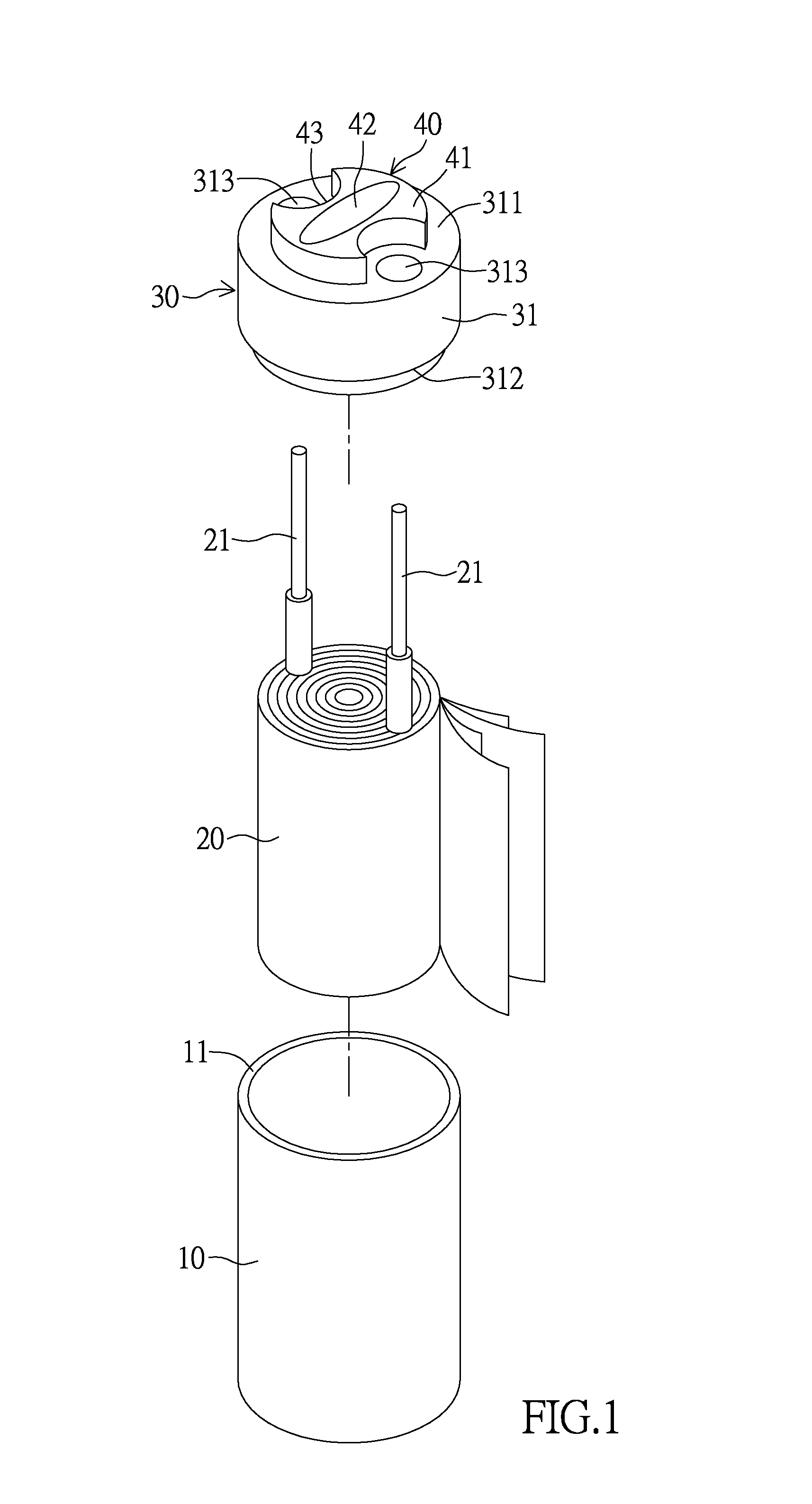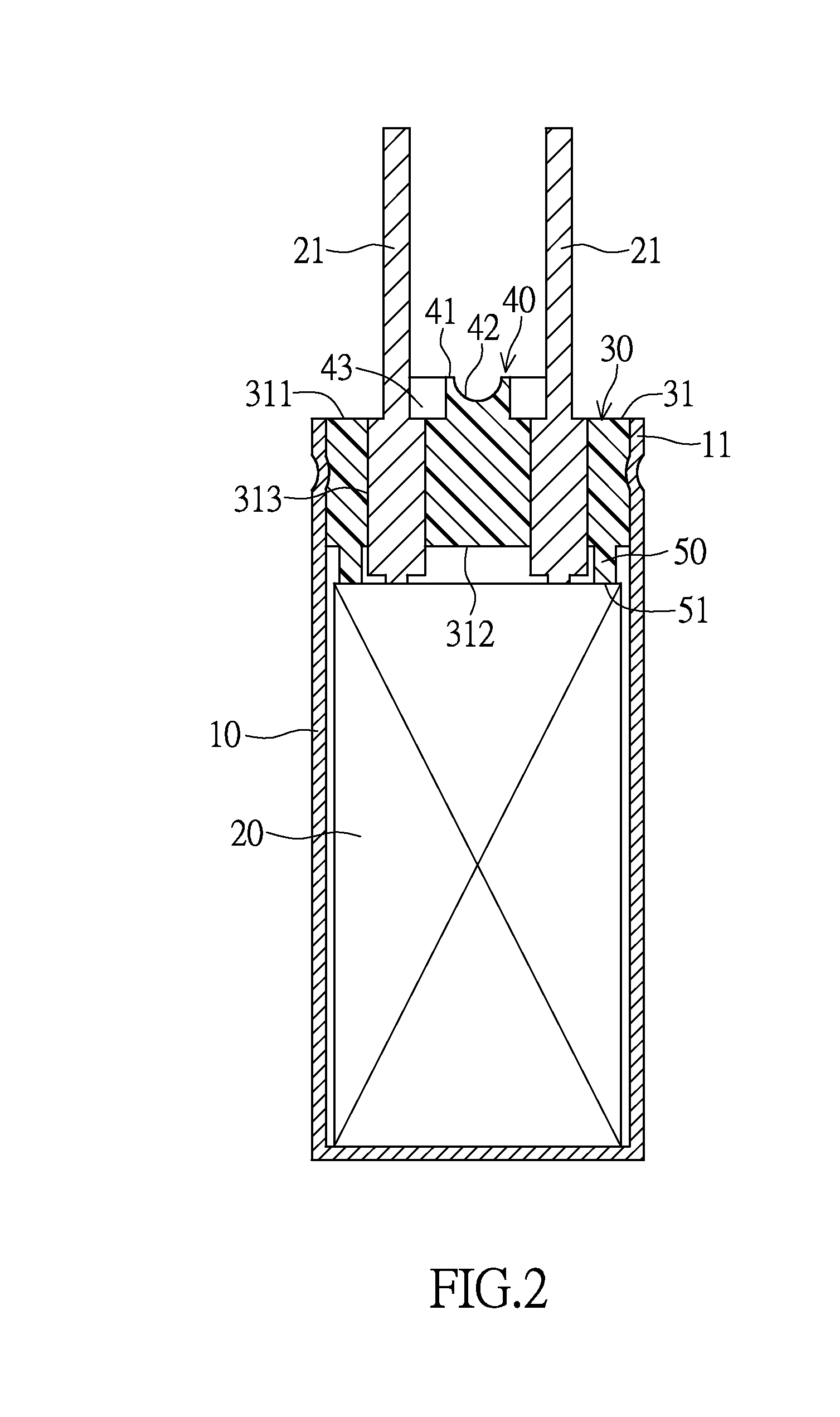Sealing element and wound-type solid state electrolytic capacitor thereof
- Summary
- Abstract
- Description
- Claims
- Application Information
AI Technical Summary
Benefits of technology
Problems solved by technology
Method used
Image
Examples
first embodiment
[0032]Please refer to FIGS. 1 and 2 as a structural illustration of a wound-type solid state electrolytic capacitor of a sealing element in accordance with the instant embodiment. The sealing element includes a capacitor casing 10, a capacitor element 20, and a sealing element 30. The capacitor casing 10 is a casing having a sealed end and an open end 11. The capacitor element 20 is arranged in the capacitor casing 10, the capacitor element 20 is formed by wounding anode foil and cathode foil together, and the capacitor element further has two terminals 21. The sealing element 30 is arranged at the open end 11 of the capacitor casing 10, and provides excellent hermetic sealing with the capacitor casing 10 in order to group the capacitor element 20 in the capacitor element 10, prevent moisture from entering the interior of the capacitor casing 10, and maintain insulation between the anode foil and the cathode foil of the capacitor element 20.
[0033]As shown in FIGS. 3 to 6, the sealin...
second embodiment
[0040]As shown in FIG. 8 as the second embodiment of the instant disclosure, the sealing member 30 has a plurality of exterior convex portion 40 arranged on the first surface 311 of the cover body 31. In the instant embodiment, the exterior convex portion 40 is defined as the plurality of protrusions protruding from the first surface 311 of the cover body 31. The protrusions extend from the first surface 311 and towards a direction away from the first surface 311. Each protrusion has the first abutting surface 41 arranged on the apex thereof. As shown in FIG. 8, each protrusion of the exterior convex portion 40 is spaced apart from another protrusion by a gap 44 so that none of the protrusions are connected to one another.
[0041]Each exterior convex portion 40 of the instant embodiment is separated by a gap 44 from another exterior convex portion 40, and each gap 44 that is arranged between two adjacent exterior convex portions 40 is a recessed space, so that any two adjacent exterio...
third embodiment
[0042]FIG. 9 illustrates the third embodiment of the instant disclosure. The third embodiment is a modification of the sealing element 30 as disclosed in the first embodiment. The cover body 31 of the instant disclosure has two annularly shaped ribs arranged on the second surface. The two annular ribs make up the two interior convex portions 50, and the two interior convex portions 50 extend from the second surface 312 and towards a direction away from the second surface 312. Each interior convex portion 50 has a second abutting surface 51 arranged on an apex thereof, and the second abutting surface 51 is partially in contact with the outer surface of the capacitor element 20.
[0043]Notably in the embodiment, the quantity of interior convex portions 50 that are arranged on the second surface of the cover body 31 of the sealing member 30 is not limited to one, and can be increased as required.
PUM
 Login to View More
Login to View More Abstract
Description
Claims
Application Information
 Login to View More
Login to View More - R&D
- Intellectual Property
- Life Sciences
- Materials
- Tech Scout
- Unparalleled Data Quality
- Higher Quality Content
- 60% Fewer Hallucinations
Browse by: Latest US Patents, China's latest patents, Technical Efficacy Thesaurus, Application Domain, Technology Topic, Popular Technical Reports.
© 2025 PatSnap. All rights reserved.Legal|Privacy policy|Modern Slavery Act Transparency Statement|Sitemap|About US| Contact US: help@patsnap.com



